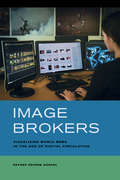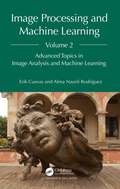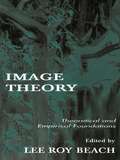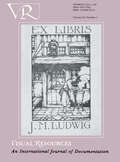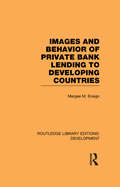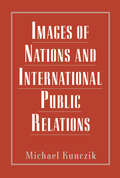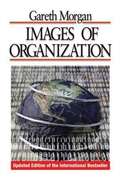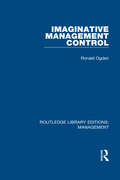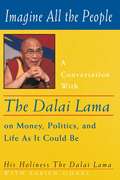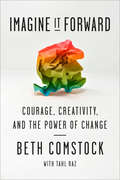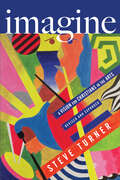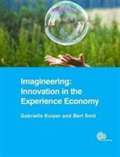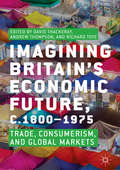- Table View
- List View
Ilva Steel Taranto: Providing and Polluting (C)
by Lena G. Goldberg Vincent Dessain Karol Misztal Ottavia PesceSupplement
Im Brennpunkt der Wirtschaftspolitik: Innovation, Globalisierung und Klimawandel
by Christian KeuschniggDieser Open-Access-Sammelband zeigt, wie innovative Forschung und Lehre in der Volkswirtschaftslehre zu einer besseren Gesellschaft beitragen können. Eine Wirtschaftspolitik mit Ziel und Plan sollte auf rigorosem theoretischem Fundament stehen und sich auf verlässliche empirische Evidenz stützen. Damit die Forschung Wirkung entfalten kann, müssen die Forscher die neuesten Erkenntnisse in eine populäre Sprache übersetzen, damit sie einer breiten und nicht spezialisierten Öffentlichkeit zugänglich werden. Wähler und Entscheidungsträger der Politik können von den Ergebnissen der Forschung nur profitieren, wenn diese in nicht-technischer Sprache zugänglich sind. Die Aufgaben der Universitäten sind Forschung, Lehre und Information der Öffentlichkeit. Im Projekt "Next Generation" fassen die besten Masterstudierenden der Universität St. Gallen politikrelevante Ergebnisse der volkswirtschaftlichen Forschung populär zusammen. Mit diesem "Readers Digest" der Ökonomie leisten sie einen wichtigenBeitrag zur dritten Mission der Universität.
Image Brokers: Visualizing World News in the Age of Digital Circulation
by Zeynep Devrim GürselHow does a photograph become a news image? An ethnography of the labor behind international news images, Image Brokers ruptures the self-evidence of the journalistic photograph by revealing the many factors determining how news audiences are shown people, events, and the world. News images, Zeynep Gürsel argues, function as formative fictions - fictional insofar as these images are constructed and culturally mediated, and formative because their public presence and circulation have real consequences in the world. Set against the backdrop of the War on Terror and based on fieldwork conducted at photojournalism's centers of power, Image Brokers offers an intimate look at an industry in crisis. At the turn of the 21st century, image brokers--the people who manage the distribution and restriction of news images--found the core technologies of their craft, the status of images, and their own professional standing all changing rapidly with the digitalization of the infrastructures of representation. From corporate sales meetings to wire service desks, newsrooms to photography workshops and festivals, Image Brokers investigates how news images are produced and how worldviews are reproduced in the process.
Image Processing and Machine Learning, Volume 2: Advanced Topics in Image Analysis and Machine Learning
by Erik Cuevas Alma Nayeli RodríguezImage processing and machine learning are used in conjunction to analyze and understand images. Where image processing is used to pre-process images using techniques such as filtering, segmentation, and feature extraction, machine learning algorithms are used to interpret the processed data through classification, clustering, and object detection. This book serves as a textbook for students and instructors of image processing, covering the theoretical foundations and practical applications of some of the most prevalent image processing methods and approaches. Divided into two volumes, this second installment explores the more advanced concepts and techniques in image processing, including morphological filters, color image processing, image matching, feature-based segmentation utilizing the mean shift algorithm, and the application of singular value decomposition for image compression. This second volume also incorporates several important machine learning techniques applied to image processing, building on the foundational knowledge introduced in Volume 1. Written with instructors and students of image processing in mind, this book’s intuitive organization also contains appeal for app developers and engineers.
Image Theory: Theoretical and Empirical Foundations (Organization and Management Series)
by Lee Roy BeachDecision making plays a major role in virtually every theory of organizational behavior. However, decision theory has not provided organizational theorists with useful descriptions of how decisions are made, either by individuals or by individuals in organizations. The earliest offering came from economics in the form of the "normative" rational view of decision making. The underlying presumption was that decision makers are all striving to maximize return or minimize loss, that decisions are based upon unlimited information, and that they have the capacity to use the information efficiently. They know the options open to them and the consequences of pursuing one or another of those options. The optimal course of action is revealed by applying the appropriate analysis and choosing the most profitable option. The key concepts are rationality, analysis, orderliness, and maximization, and even a moment's thought demonstrates the gap between these concepts and real-life experience. From the viewpoint of organizational theory, the primary problem with the normative view of decision making, and by analogy with much behavioral decision research, is its reliance on the "gamble metaphor." That is, decisions are characterized as gambles in an effort to capture the inherent risk. This metaphor has the advantage of simplicity, but it is a flawed simplicity. This book is about a different kind of behavioral theory -- image theory. It is a psychological theory of decision making that abandons the gamble metaphor and the normative logic that the metaphor supports. Instead it sees decision making as guided by the beliefs and values that the decision maker, or a community of decision makers, holds to be relevant to the decision at hand. These beliefs and values dictate the goals of the decision. The point is to craft a course of action that will achieve these goals without interfering with the pursuit of other goals. The book begins with an overview of image theory that outlines the basic concepts of the theory and a little of its history. The next two parts correspond to the theory's two decision mechanisms, the compatibility test and the profitability test. The final section contains extensions and developments of the theory as well as cognate ideas that have their basis in the theory. This book's purpose is to provide -- in one place -- the theoretical and empirical work that has been done up to now and to suggest directions for future work.
Image of America
by R. L. Bruckberger"Either America is the hope of the world, or it is nothing. There are those who have begun to despair of the West. It is for them that I am writing." Thus the author states his intention. The result is a book -- in the tradition of Tocqueville and Bryce -- in which we see ourselves through the sympathetic, critical eyes of a Frenchman who as Chaplain General of the Resistance has seen the life of action and as scholar, author, and priest knows the life of the spirit. He lived for eight years in this country, thought deeply about it, and came to love and admire it. His eyes and ears picked up sights and sounds that ours do not. The heroes he admires are not, in most instances, the ones we should choose. The ideas and ideals that have shaped our history and our character as a nation, seen in the perspective of the ancient traditions of Europe, take on a new meaning. From hitherto unused or misused material an image of America emerges that is as enlightening as it is surprising. "To some of the problems that most torment the European conscience," Father Bruckberger writes, "America, I am convinced, has found answers, and found them with no disavowal of the European heritage. America brings to this Western heritage something concrete of its own. . . ." How has this come about? What is the essential spark that has won so vital a role for this country in the angry and perilous world of today? The answer, says the author, lies in our regard for the individual, for the non-abstract, living human being. This theme, contrasted with the heresy of Europe (the subordination of Man to abstraction), is developed with wit and insight in the author's reflections on our political principles and institutions, on our economic beliefs, and on our business and social achievements.
Images Libraries Museums/Arch
by Amy MccollFirst Published in 1997. Routledge is an imprint of Taylor & Francis, an informa company.
Images and Behaviour of Private Bank Lending to Developing Countries (Routledge Library Editions: Development)
by Margee M. EnsignThe primary questions addressed by this study, first published in 1988, focus on how private bankers made decisions on the creditworthiness of developing countries during the 1970s and what the implications of these decision rules are for the developing countries today. Based on interviews with senior bankers about their decision rules, the author has developed artificial intelligence-based simulations of their images of creditworthiness. Discussed are contemporary proposals for solving the debt crisis.
Images from the Arsenal of Democracy: Images From The Arsenal Of Democracy
by Charles K. HydeWhile researching his previous study, Arsenal of Democracy: The American Automobile Industry in World War II (Wayne State University Press, 2013), award-winning automotive historian Charles K. Hyde discovered the many remarkable photos that were part of the era's historical documentation. In Images from the Arsenal of Democracy, Hyde presents a selection of nearly three hundred of these documentary photos in striking black and white, with brief captions. Taken together, the images create a captivating portrait of this crucial moment in American business, military, and cultural history. Images from the Arsenal of Democracy spans from 1940 until the end of the war, presenting up-close, rarely seen views of newly built plants and repurposed production lines, a staggering variety of war products and components, and the many workers behind Detroit's wartime production miracles. The human faces that Hyde presents are especially compelling, as photos show the critical role played by previously underused workers--namely women and African Americans. Images from the Arsenal is divided into chapters by theme, including "Preparing for War before Pearl Harbor"; "Planning Defense Production after Pearl Harbor"; "Aircraft Engines and Propellers"; "Aircraft Components and Complete Aircraft"; "Tanks and Other Armored Vehicles"; "Jeeps, Trucks, and Amphibious Vehicles"; "Guns, Shells, Bullets, and Other War Goods"; "The New Workers"; and "Celebrating the Production Achievements." The first comprehensive and detailed history drawn solely from the surviving photographic record of wartime Detroit, Images from the Arsenal will be appreciated by automotive historians, World War II scholars, and American history buffs.
Images of Nations and International Public Relations (Routledge Communication Series)
by Michael KunczikThis volume addresses the importance of images of nations in international relations. One fundamental assumption is that the behavior of states is not the same as that of individuals. States are social systems whose behavior as a rule directly corresponds neither to the motives of their respective leaders nor to those of their populations. However, it is also self-evident that international activities always depend on personal relationships. The studies presented relate to more or less deliberate attempts to induce change in images. Given the interdisciplinary nature of the subject matter, findings made in public relations, advertising research, prejudice research and other fields are also taken into account. Very often it is impossible to distinguish between the image of the nation-state and the images of big enterprises such as Krupp, Ford, or Coca Cola. For this reason, the country of origin effect is also discussed.
Images of Organization (Updated Edition)
by Gareth MorganMorgan (Schulich School of Business, York U. , Toronto) approaches management with the premise that all theories of organization and management are based on implicit images or metaphors which stretch imaginations to create powerful insights and that they do so at the risk of distortion. This updated edition contains new references and tables, as well as a preface that situates Morgan's theory in the current business environment.
Images of Organization: 30th Anniversary Edition
by Professor Gareth MorganSince its first publication over twenty years ago, Images of Organization has become a classic in the canon of management literature. The book is based on a very simple premise—that all theories of organization and management are based on implicit images or metaphors that stretch our imagination in a way that can create powerful insights, but at the risk of distortion. Gareth Morgan provides a rich and comprehensive resource for exploring the complexity of modern organizations internationally, translating leading-edge theory into leading-edge practice.
Images of Organization: 30th Anniversary Edition
by Professor Gareth MorganSince its first publication over twenty years ago, Images of Organization has become a classic in the canon of management literature. The book is based on a very simple premise—that all theories of organization and management are based on implicit images or metaphors that stretch our imagination in a way that can create powerful insights, but at the risk of distortion. Gareth Morgan provides a rich and comprehensive resource for exploring the complexity of modern organizations internationally, translating leading-edge theory into leading-edge practice.
Images of Projects
by Mark Winter Tony SzczepanekIn this very distinctive book, Images of Projects challenges how we think about projects in the most fundamental way: it rejects outright the idea of a one 'best way' to view all projects and also the idea of following a prescriptive approach. In contrast, Images of Projects seeks to encourage a more pragmatic and reflective approach, based on deliberately seeing projects from multiple perspectives, exploring the insights and implications which flow from these, and crafting appropriate action strategies in complex situations. Based on real examples and the authors' work over the last ten years, Images of Projects presents seven pragmatic images for making sense of the complex realities of projects. Illustrated using various models, these images are presented in ways that allow the reader to reflect upon their own mental models in relation to the different perspectives in this book.
Imagination und Bildlichkeit der Wirtschaft: Zur Geschichte und Aktualität imaginativer Fähigkeiten in der Ökonomie
by Walter Otto Ötsch Silja GraupeDer vorliegende Band stellt ein erstes Grundlagenwerk zur Imaginationsforschung in der Ökonomie dar. Er erforscht die ökonomische Theoriegeschichte (auch mit Bezug auf die Philosophiegeschichte) und fragt, welche Bilder und Selbstbilder über Menschen, über das wirtschaftliche System und über die Zukunft in ökonomischen Theorien enthalten sind. Wie ist die Beschäftigung mit Imaginationen im Mainstream der Wirtschaftswissenschaften verloren gegangen und wie kann sie wiederbelebt werden?Prof. Dr. Walter Otto Ötsch ist Professor für Ökonomie und Kulturgeschichte an der Cusanus Hochschule für Gesellschaftsgestaltung.Prof. Dr. Silja Graupe ist Professorin für Ökonomie und Philosophie und Leiterin des Instituts für Ökonomie der Cusanus Hochschule für Gesellschaftsgestaltung.
Imaginative Leadership: How Leaders of Marginalized Groups Negotiate Intergroup Relations
by Jolanda Jetten Frank MolsWhat separates leaders like Nelson Mandela and Mahatma Gandhi from the leaders found in convention guidebooks on leadership is that they were able to lead despite persecution, imprisonment, and other obstacles. Their reality stands in contrast to the implicit assumption often found in leadership research: that leaders can choose from a wide range of strategies. Existing leadership models are inadequate for understanding leadership of groups that are marginalized--leaders of marginalized groups are seldom in a position to choose what course of action to take to achieve group objectives. In this chapter, the authors look at what makes leaders like Mandela and Gandhi so effective, and discuss leadership strategies that leaders of marginalized groups can pursue. They argue that the extent to which devalued groups and their leaders share identity determines the extent to which leaders can change, influence, and steer the group, and manage intergroup relations. This chapter was previously published as chapter 5 of "Crossing the Divide: Intergroup Leadership in a World of Difference."
Imaginative Management Control (Routledge Library Editions: Management #47)
by Ronald OgdenOriginally published in 1970. Drawing on his knowledge of business methods in Europe, America and Asia, Ronald Ogden examines the necessity for control in a business and the ways in which it should be exercised in order to obtain the most effective and profitable results. He shows that control can be exercised through carefully planned objectives which must, in their turn, be broken down into clearly defined targets. Realistic planning is discussed, and the author considers the effective implementation of plans by means of various techniques such as budgeting, costing, staff control, operational research, and network planning. The study will be of interest not only to managers but also to students of management concerned with modern business techniques and with the functions and responsibilities of management and control.
Imagine All the People: A Conversation with the Dalai Lama on Money, Politics, and Life As It Could Be
by His Holiness the Dalai Lama Anne Benson Fabien OuakiIf you could sit down with the Dalai Lama and talk with him about anything, what would you discuss? Fabien Ouaki, a prominent French businessman, was granted such an opportunity and asked the Dalai Lama for his thoughts on the everyday issues that fill our newspapers and our lives. This is the record of these varied and remarkable conversations. Covered are a wide spectrum of topics - political, social, personal and spiritual - including the media and education, marriage and sex, and disarmament and compassion. Blessed by His Holiness' buoyant and insightful thoughts, Imagine All the People allows readers to glimpse the spontaneous workings of an extraordinary mind at once of - and above - this world. Includes the full text of The Global Community and the Need for Universal Responsibility.If you could sit down with the Dalai Lama and talk with him about anything, what would you discuss? Fabien Ouaki, a prominent French businessman, was granted such an opportunity and asked the Dalai Lama for his thoughts on the everyday issues that fill our newspapers and our lives. This is the record of these varied and remarkable conversations. Covered are a wide spectrum of topics - political, social, personal and spiritual - including the media and education, marriage and sex, and disarmament and compassion. Blessed by His Holiness' buoyant and insightful thoughts, Imagine All the People allows readers to glimpse the spontaneous workings of an extraordinary mind at once of - and above - this world. Includes the full text of The Global Community and the Need for Universal Responsibility.
Imagine It Forward: Courage, Creativity, and the Power of Change
by Tahl Raz Beth ComstockFROM ONE OF TODAY'S FOREMOST INNOVATION LEADERS, AN INSPIRING, PERSONAL APPROACH TO MASTERING CHANGE IN THE FACE OF UNCERTAINTY. Confronting change is incredibly hard, both organizationally and personally. People become resistant. They are afraid. Yet the pace of change in our world will never be slower than it is right now, says Beth Comstock, the former Vice Chair and head of marketing and innovation at GE. Imagine It Forward is an inspiring, fresh, candid, and deeply personal book about how to grapple with the challenges to change we face every day. It is a different kind of narrative, a big picture book that combines Comstock’s personal story in leading change with vital lessons on overcoming the inevitable roadblocks. One of the most successful women in business, Comstock shares her own transformation story from introverted publicist to GE’s first woman Vice Chair, and her hard-won lessons in shifting GE, a 125 year old American institution, toward a new digital future and a more innovative culture. As the woman who initiated GE's Ecomagination clean-energy and its (and NBC’s) digital transformations, Comstock challenged a global organization to not wait for perfection, but to seek out emerging trends, embrace smart risks and test ideas boldly, and often. She shows how each one of us can become a “change maker” by leading with imagination. “Ideas are rarely the problem,” writes Comstock. “What holds all of us back, really—is fear. It’s the attachment to the old, to ‘What We Know.’” As Comstock makes clear, transforming the mindset and culture of a company is messy. There is no easy checklist. It is fraught with uncertainty, tension and too often failure. It calls for the courage to defy convention, go around corporate gatekeepers when necessary, and reinvent what is possible. For all those looking to spearhead change in their companies and careers, and reinvent “the way things are done,” Imagine It Forward masterfully points the way.
Imagine It Forward: Courage, Creativity, and the Power of Change
by Tahl Raz Beth ComstockFrom one of today’s foremost innovation leaders, an inspiring and practical guide to mastering change in the face of uncertainty.The world will never be slower than it is right now, says Beth Comstock, the former Vice Chair and head of marketing and innovation at GE. But confronting relentless change is hard. Companies get disrupted as challengers steal away customers; employees have to move ahead without knowing the answers. To thrive in today’s world, every one of us has to make change part of our job. In Imagine It Forward, Comstock, in a candid and deeply personal narrative, shares lessons from a thirty year career as the change-maker in chief, navigating the space between the established and the unproven. As the woman who initiated GE's digital and clean-energy transformations, and its FastWorks methodology, she challenged a global organization to not wait for perfection but to spot trends, take smart risks and test new ideas more often. She shows how each one of us can—in fact, must—become a “change maker.” “Ideas are rarely the problem,” writes Comstock. “What holds all of us back, really—is fear. It’s the attachment to the old, to ‘What We Know.’” Change is messy and fraught with tension, uncertainty and failure. Being “change ready” calls for the courage to defy convention, the resilience to overcome doubts, and the savvy to know when to go around corporate gatekeepers to reinvent what is possible. Among the practical takeaways Comstock offers: • The power of discovery—bringing the outside into your organization. It’s about turning the world into a classroom. • Find a spark—provocateurs who challenge established ways of thinking can be a powerful catalyst for change. • Give yourself permission—every change maker must learn to give herself permission to push outside expectations and boundaries. Confronting today’s accelerating change requires an extraordinary degree of problem-solving, collaboration, and forward-thinking leadership to unlock every person’s potential. Imagine It Forward masterfully points the way.
Imagine: A Vision for Christians in the Arts
by Steve TurnerImagine art that is risky, complex, and subtle. Imagine music, movies, books, and paintings of the highest quality. Imagine art that permeates society, challenging conventional thinking and standard morals to their core. Imagine that it is all created by Christians! This is the bold vision of Steve Turner, who has worked among a wide variety of artists for decades. He believes Christians should confront society and the church using art's powerful impact. Art can faithfully chronicle the lives of ordinary people and express the transcendence of God. And Christians should be involved in every level of the art world and in every medium. In this revised and expanded edition of a contemporary classic, Turner builds a compelling case for Christians in the arts. If Jesus is Lord of all of life and creation, then art is part of his cultural mandate. It can and should be a way of expressing faith through creatively, beautifully, and truthfully arranged words, sounds, and sights. Now includes study questions for individual reflection or group discussion.
Imagined Futures: Fictional Expectations and Capitalist Dynamics
by Jens BeckertConsumers, investors, and corporations orient their activities toward a future that contains opportunities and risks. How do these actors assess uncertainty? Jens Beckert adds a new chapter to the theory of capitalism by showing how fictional expectations drive modern economies--or throw them into crisis when imagined futures fail to materialize.
Imagineering: Innovation in the Experience Economy
by Gabrielle Kuiper Bert SmitTo survive in today's complex economies, it is imperative for companies to understand their consumers in terms of how and why they like to use their products. Distinction based on quality no longer provides competitive advantage. Imagineers use design methods to create meaningful experiences that connect consumers to brands, employees to companies and consumers to consumers. This book explains the background of the need for experiences and then focusses on how to design them. Bringing theory into practice for students of tourism marketing, event planning and business, it provides a window into the creative world of Imagineering.
Imaging in Advertising: Verbal and Visual Codes of Commerce
by Fern L. JohnsonThe dominance of advertising in everyday life carries potent cultural meaning. As a major force in the rise of "image based culture," advertising spreads images that shape how people live their lives. While scholarship on visual images has advanced our understanding of the role of advertising in society, for example in revealing how images of extremely thin female models and athletic heroes shape ideals and aspirations, images circulated through lagnuage codes--or "verbal images"--in advertising have received less attention. Imaging in Advertising explores how the verbal and visual work together to build a discourse of advertising that speaks to audiences and has the power to move them to particular thoughts and actions. In this book, Fern L. Johnson presents a series of case studies exploring important advertising images--racial connotations in cigarette advertising, representations of cultural diversity in teen television commercials, metaphors of the face appearing in ads for skin care products, language borrowed from technology to sell non-technology products, and the illusion of personal choice that is promoted in many Internet web sites. Johnson argues that examining the interplay of verbal and visual images as a structured whole exposes the invase role of advertising in shaping culture in 21st century America.
Imagining Britain’s Economic Future, c.1800–1975: Trade, Consumerism And Global Markets
by Andrew Thompson Richard Toye David ThackerayFollowing the Brexit vote, this book offers a timely historical assessment of the different ways that Britain’s economic future has been imagined and how British ideas have influenced global debates about market relationships over the past two centuries. The 2016 EU referendum hinged to a substantial degree on how competing visions of the UK should engage with foreign markets, which in turn were shaped by competing understandings of Britain’s economic past. The book considers the following inter-related questions: - What roles does economic imagination play in shaping people’s behaviour and how far can insights from behavioural economics be applied to historical issues of market selection? - How useful is the concept of the ‘official mind’ for explaining the development of market relationships? - What has been the relationship between expanding communications and the development of markets? - How and why have certain regions or groupings (e.g. the Commonwealth) been ‘unimagined’- losing their status as promising markets for the future?


